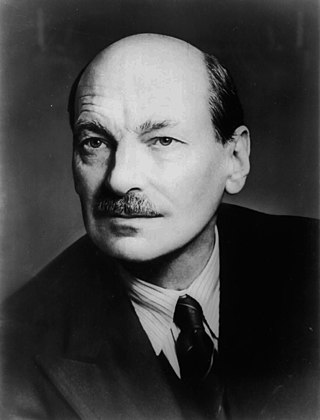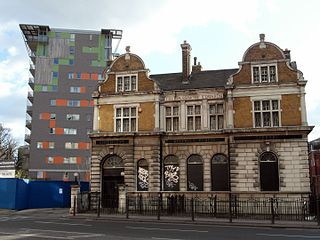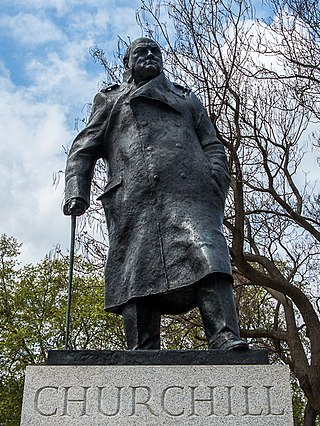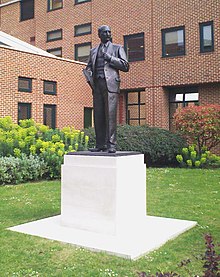
Clement Richard Attlee, 1st Earl Attlee, was a British statesman and Labour Party politician who served as Prime Minister of the United Kingdom from 1945 to 1951 and Leader of the Labour Party from 1935 to 1955. Attlee served as Deputy Prime Minister during the wartime coalition government under Winston Churchill, and Leader of the Opposition twice from 1935 to 1940 and from 1951 to 1955. He remains the longest serving Labour leader.

The 1945 United Kingdom general election was a national election held on Thursday 5 July 1945, but polling in some constituencies was delayed by some days, and the counting of votes was delayed until 26 July to provide time for overseas votes to be brought to Britain. The governing Conservative Party sought to maintain its position in Parliament but faced challenges from public opinion about the future of the United Kingdom in the post-war period. Prime Minister Winston Churchill proposed to call for a general election in Parliament, which passed with a majority vote less than two months after the conclusion of the Second World War in Europe.

Woodford Green is an area of Woodford in East London, England, within the London Borough of Redbridge. It adjoins Buckhurst Hill to the north, Woodford Bridge to the east, South Woodford to the south, and Chingford to the west. Epping Forest runs through Woodford Green in the west of the area, 9.4 miles (15.1 km) north-east of Charing Cross.

Frederick William Pethick-Lawrence, 1st Baron Pethick-Lawrence, PC was a British Labour politician who, among other things, campaigned for women's suffrage.
The 1935 Labour Party leadership election took place on 26 November 1935 when Herbert Morrison and Arthur Greenwood challenged Clement Attlee, the incumbent party leader of only one month and one day. Attlee, previously Deputy Leader, had been appointed as an interim leader the previous month when George Lansbury resigned and the general election was looming.

Limehouse was a borough constituency centred on the Limehouse district of the East End of London. It returned one Member of Parliament (MP) to the House of Commons of the Parliament of the United Kingdom.

Limehouse Public Library is a historical building in Limehouse, London, formerly a public library. The library was first proposed for construction in 1888, but the required finances could not be raised until 1900 when John Passmore Edwards was approached for assistance. He subscribed a sum of £5,000 and he subsequently laid the foundation stone on 19 October that year. The library was opened to the public in November 1901 by the mayor of Stepney.

The Members' Lobby is a hallway in the Palace of Westminster used by members of the House of Commons, the lower house of the Parliament of the United Kingdom. Members of Parliament may congregate here for discussions while not dealing with other business.

The Churchill war ministry was the United Kingdom's coalition government for most of the Second World War from 10 May 1940 to 23 May 1945. It was led by Winston Churchill, who was appointed Prime Minister of the United Kingdom by King George VI following the resignation of Neville Chamberlain in the aftermath of the Norway Debate.

The Churchill caretaker ministry was a short-term British government in the latter stages of the Second World War, from 23 May to 26 July 1945. The prime minister was Winston Churchill, leader of the Conservative Party. This government succeeded the national coalition which he had formed after he was first appointed prime minister on 10 May 1940. The coalition had comprised leading members of the Conservative, Labour, and Liberal parties and it was terminated soon after the defeat of Nazi Germany because the parties could not agree on whether it should continue until after the defeat of Japan.

Into the Storm or Churchill at War(alt. title) is a 2009 biographical film about Winston Churchill and his days in office during the Second World War. The movie is directed by Thaddeus O'Sullivan and stars Brendan Gleeson as the British Prime Minister. Into the Storm is a sequel to the 2002 television film The Gathering Storm, which details the life of Churchill in the years just prior the war. Into the Storm had its first public premiere on HBO and HBO Canada on 31 May 2009.

The statue of Winston Churchill in Parliament Square, London, is a bronze sculpture of the former British prime minister Winston Churchill, created by Ivor Roberts-Jones.

Nelson Mandela is a bronze sculpture in Parliament Square, London, of former President of South Africa and anti-apartheid activist Nelson Mandela. Originally proposed to Mandela by Donald Woods in 2001, a fund was set up and led by Woods's wife and Richard Attenborough after the death of Woods. The then Mayor of London Ken Livingstone obtained permission from Westminster City Council to locate the statue on the north terrace of Trafalgar Square, but after an appeal it was located in Parliament Square instead where it was unveiled on 29 August 2007.
Sir David Bruce Pitblado KCB CVO was a principal private secretary to the office of the Prime Minister of the United Kingdom. Serving from 1951 to 1956, he was associated with Prime Ministers Clement Attlee, Winston Churchill, and Anthony Eden. With his colleague Jock Colville, he was one of Churchill's last two principal private secretaries at 10 Downing Street.

The equestrian statue of Ferdinand Foch stands in Lower Grosvenor Gardens, London. The sculptor was Georges Malissard and the statue is a replica of another raised in Cassel, France. Foch, appointed Supreme Commander of the Allied Forces on the Western Front in the Spring of 1918, was widely seen as the architect of Germany's ultimate defeat and surrender in November 1918. Among many other honours, he was made an honorary Field marshal in the British Army, the only French military commander to receive such a distinction. Following Foch's death in March 1929, a campaign was launched to erect a statue in London in his memory. The Foch Memorial Committee chose Malissard as the sculptor, who produced a replica of his 1928 statue of Foch at Cassel. The statue was unveiled by the Prince of Wales on 5 June 1930. Designated a Grade II listed structure in 1958, the statue's status was raised to Grade II* in 2016.

Twickenham War Memorial, in Radnor Gardens, Twickenham, London, commemorates the men of the district of Twickenham who died in the First World War. After 1945, the memorial was updated to recognise casualties from the Second World War. The memorial was commissioned by Twickenham Urban District Council in 1921. It was designed by the sculptor Mortimer Brown, and is Brown's only significant public work. The memorial is unusual for its representation of a jubilant soldier returning home. It became a Grade II* listed structure in 2017.

The statue of Winston Churchill in Woodford, London, is a bronze sculpture of the British statesman, created by David McFall in 1958–9. The statue commemorates Churchill's role as the member for the parliamentary constituency of Woodford. Churchill was elected to the Epping seat in 1924 and held it until 1945 when the new constituency of Woodford was created. Churchill then held this seat until his retirement in 1964. The statue is a Grade II listed structure.

The Gladstone Memorial on the Strand, London is a bronze sculpture of the British statesman, created by Hamo Thornycroft between 1899-1905. The statue was erected as the national memorial to Gladstone and shows him in the robes of the Chancellor of the Exchequer. The figure stands on a plinth surrounded by allegorical figures depicting four of the Virtues, Courage, Brotherhood, Education and Aspiration. The memorial is a Grade II listed structure.















